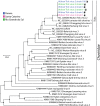Viral diversity of Rhipicephalus microplus parasitizing cattle in southern Brazil
- PMID: 30397237
- PMCID: PMC6218518
- DOI: 10.1038/s41598-018-34630-1
Viral diversity of Rhipicephalus microplus parasitizing cattle in southern Brazil
Abstract
Ticks are ectoparasites spread worldwide and are well known as vectors of many viruses of great importance to human and animal health. However, the viral diversity in ticks is still poorly understood, particularly in South America. Here we characterized the viral diversity present in Rhipicephalus microplus parasitizing cattle in the southern region of Brazil using metagenomics. Our study revealed the presence of viruses that had not been previously described in the region, including lihan tick virus (Phenuiviridae family) and wuhan tick virus 2 (Chuviridae family), as well as expands the biogeography of jingmen tick virus (Flaviviridae family) in Brazil. Also, we described three novel tymoviruses (Tymovirales order), named guarapuava tymovirus-like 1 to 3. We described the genomic and phylogenetic characterization of these viruses. Our study sheds light on the viral diversity of Rhipicephalus microplus in South America, and also expands the biogeography of tick viruses that were previously described only in Asia.
Conflict of interest statement
The authors declare no competing interests.
Figures





Similar articles
-
Metagenomic Profiling of Viruses Associated with Rhipicephalus microplus Ticks in Yunnan Province, China.Virol Sin. 2021 Aug;36(4):623-635. doi: 10.1007/s12250-020-00319-x. Epub 2021 Jan 5. Virol Sin. 2021. PMID: 33400089 Free PMC article.
-
Identification and characterization of Jingmen tick virus from Rhipicephalus microplus in Hunan, China.Acta Trop. 2024 Dec;260:107378. doi: 10.1016/j.actatropica.2024.107378. Epub 2024 Sep 6. Acta Trop. 2024. PMID: 39245157
-
Metatranscriptomic virome assessment of Rhipicephalus microplus from Colombia.Ticks Tick Borne Dis. 2020 Sep;11(5):101426. doi: 10.1016/j.ttbdis.2020.101426. Epub 2020 Apr 4. Ticks Tick Borne Dis. 2020. PMID: 32473925
-
Review of cattle ticks (Acari, Ixodida) in Ivory Coast and geographic distribution of Rhipicephalus (Boophilus) microplus, an emerging tick in West Africa.Exp Appl Acarol. 2017 Apr;71(4):355-369. doi: 10.1007/s10493-017-0129-7. Epub 2017 May 11. Exp Appl Acarol. 2017. PMID: 28497303 Review.
-
Genetic Diversity of Rhipicephalus (Boophilus) microplus for a Global Scenario: A Comprehensive Review.Pathogens. 2024 Jun 18;13(6):516. doi: 10.3390/pathogens13060516. Pathogens. 2024. PMID: 38921813 Free PMC article. Review.
Cited by
-
Diversity and circulation of Jingmen tick virus in ticks and mammals.Virus Evol. 2020 Jul 27;6(2):veaa051. doi: 10.1093/ve/veaa051. eCollection 2020 Jul. Virus Evol. 2020. PMID: 33976906 Free PMC article.
-
Monitoring Silent Spillovers Before Emergence: A Pilot Study at the Tick/Human Interface in Thailand.Front Microbiol. 2019 Oct 17;10:2315. doi: 10.3389/fmicb.2019.02315. eCollection 2019. Front Microbiol. 2019. PMID: 31681195 Free PMC article.
-
Jingmenviruses: Ubiquitous, understudied, segmented flavi-like viruses.Front Microbiol. 2022 Oct 10;13:997058. doi: 10.3389/fmicb.2022.997058. eCollection 2022. Front Microbiol. 2022. PMID: 36299728 Free PMC article. Review.
-
Novel Virus Identification through Metagenomics: A Systematic Review.Life (Basel). 2022 Dec 7;12(12):2048. doi: 10.3390/life12122048. Life (Basel). 2022. PMID: 36556413 Free PMC article. Review.
-
Detection and Characterization of Alongshan Virus in Ticks and Tick Saliva from Lower Saxony, Germany with Serological Evidence for Viral Transmission to Game and Domestic Animals.Microorganisms. 2023 Feb 21;11(3):543. doi: 10.3390/microorganisms11030543. Microorganisms. 2023. PMID: 36985117 Free PMC article.
References
Publication types
MeSH terms
Grants and funding
LinkOut - more resources
Full Text Sources
Molecular Biology Databases

